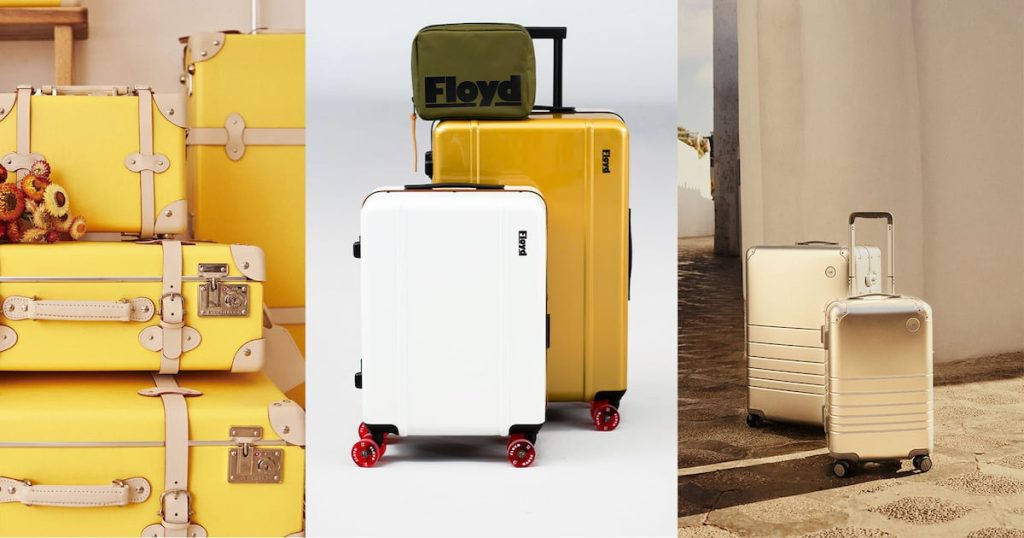Christopher Angelotti spent more than a month hunting for the perfect set of luggage ahead of a planned trip to Europe this summer. He considered direct-to-consumer brands like Away, $1,500 Rimowa hardshells, sturdy options from the century-old suitcase maker Samsonite and the trendy dupe specialist Quince, among others.
The winner? A three-piece set from ‘90s mall gadget purveyor Brookstone that he found on deep discount at Marshalls.
“It became this existential crisis where I’m like, ‘Okay, why am I spending so many emotional calories on a luggage set that I’ll only get to use once in a blue moon?‘” said Angelotti, a fashion e-commerce specialist based in New York. “Turns out, it’s just luggage. They’re all kind of the same.”
Angelotti, 37, is among the record-breaking five billion people expected to travel via flying in 2025, according to the International Air Transport Association. Most will bring at least one suitcase along with them.
The problem for brands hoping to cash in on the travel boom is that, despite the best efforts of Away, Rimowa and Béis, many tourists still don’t care all that much about the name on their suitcase (and even if they do, they’re often buying luggage hoping not to do so again for years, or even decades). There’s also no shortage of competition in a category with few barriers to entry. Many start-ups and established players alike rely on the same cluster of manufacturers in Asia to make the cases and duffels themselves. Layer on some slick branding and a Shopify storefront, and presto, a new luggage brand is born.
“You would think all the big brands are running their own factories, but 90 percent [outsource] to China,” said Bernd Georgi, co-founder of the Munich-based luggage start-up Floyd, which also manufactures in China but tries to stand out from generic competitors with proprietary flourishes like replaceable polyurethane wheels made for skateboards.
The tough economics aren’t getting any better amid signs that demand for chic suitcases has peaked — travel goods spending fell 6 percent to $6.5 billion in the US last year according to Circana, the first decline since the pandemic. Luggage brands are exploring new strategies to elbow out rivals, and fend off copycats with travel-adjacent accessories such as backpacks and pet carriers. They’re also opening stores and inking wholesale partnerships to wean themselves off relying on digital ads to find customers.

“It’s a cyclical category because people buy luggage once and then won’t buy again for a couple of years,” said Beth Goldstein, executive director and accessories analyst at Circana. “Every brand now has a similar version of the hard case and the organizational features inside. In order to keep up growth, you have to convince consumers they need better products.”
Keep Calm and Carry-On
When Sara Banks launched her luggage brand, SteamLine, in 2005, the category was dominated by Samsonite and brands sold by department stores that prioritised function over style.
“I would see all these women with gorgeous handbags but carrying boring luggage, and I thought it was interesting because your luggage is your largest accessory,” she said. With its leather shell and handmade stitching, SteamLine became a fashionable but tiny alternative to the goliaths of the industry.

Away steamrolled into the category in the 2010s, with millions in funding from Silicon Valley investors. The brand turbocharged the idea of bringing an aspirational sensibility to travel, whatever the budget (Away’s hard shell carry-on cases debuted at under $300, a little more than a similarly sized Samsonite). Around the same time Rimowa, the upscale German luggagemaker which LVMH acquired in 2016, applied a similar approach at the high end of the market.
With pervasive marketing and distinct visual identities – which provided free advertising when the cases dropped onto the airport luggage carousel – both brands incepted into the minds of consumers that suitcases could be elevated and fashionable.
Away didn’t have the market to itself for long. Sustainability focused Paravel launched in 2016; former Tumi executives started Roam in 2017; the Canadian brand Monos launched in 2018, and actress Shay Mitchell’s Béis arrived the same year; the Australian brand July was founded in 2019.
“When we looked into the luggage space, we found a gap in how customers were served,” said Monos co-founder Victor Tam. “Away scratched the surface of the fashionisation of this world.”
But unlike fashion, people don’t buy new luggage every season, or even every decade. By the time 2020 came around, the newly crowded market was already starting to decelerate, according to Circana’s Goldstein. Following the pandemic, the “revenge travel” craze catapulted growth once again.
But that momentum has again slowed in recent months. In the US, consumer confidence is plunging, raising fears in the luggage world that travellers will opt to steer cash once earmarked for a new suitcase towards the trip itself. Luggage may also get more expensive, as so much of it is made in China and therefore subject to new tariffs.
Reinventing the Wheel
Dozens of online guides arrive at a dizzying array of conclusions about which brand is best. The New York Times’ Wirecutter top-ranked carry-on option is the Travelpro soft-sided suitcase, while New York Magazine’s Strategist recommends Away’s signature polycarbonate spinner. Condé Nast Traveller, meanwhile, named Paravel’s retro-style hard-side suitcase as its overall top pick.
For some shoppers, the lack of consensus can trigger a sort of paralysis.
“The algorithm is feeding me so much content on what’s the best suitcase and how to pack and so on,” said Kate Lindello, 40, founder of resale fashion marketplace Noihsaf Bazaar.
After using the same piece of Ricardo Beverly Hills luggage she borrowed from her parents for the last two decades, Lindello said she’s been trying and failing to upgrade for the last year.
“Maybe I’ll just embrace my chaos goblin traveling ways and throw away trying to be chic,” she said.
While shoppers can be overwhelmed by the sheer volume of luggage brands, there’s a creeping sameness to the sea of options: four wheels, a hard polycarbonate shell and two zipped compartments inside. That’s in part because while there are many suppliers of luggage parts and assembly, brands are more or less sourcing from the same pool of vendors.
BoF analysis of import data found several examples of manufacturers in Asia that served multiple large luggage brands. For example, Eminent Luggage Corp., a supplier based in Taiwan, counts Samsonite, Away, Tumi, Delsey and Brookstone as its top trade partners. Another factory group, Jionbags, works with Samsonite, American Tourister and Baboon to the Moon.
Investing in innovation will be critical in driving demand as the category matures.
It isn’t easy. When Georgi and his partner were in the process of designing Floyd, he was surprised to learn that to create detachable wheels would require inventing their own axis system, which they were ultimately able to accomplish.
“To be honest I was questioning why nobody is coming up with a new wheel system?” he said. “Why do we have to be the first ones?”
It took Harper Collective’s co-founders Sebastian Manes and Jaden Smith four-and-a-half years to build a supply chain that supported their vision for a suitcase that’s made of 70 percent recycled plastic. Today, the brand operates assembly ateliers in Italy and the UK, and works alongside German plastics company Epsotech to develop its proprietary shell. Its niche production is reflected in a steep price tag: $850 for its standard carry-on.
Other luggage companies are relying on collaborations and new products to encourage repeat purchases. SteamLine, for instance, built out a line of matching luggage, from its signature trunk-style roller suitcases to hat boxes and duffels, and offers lifetime customer service regarding repairs and refurbishment. Away, meanwhile, launched its first soft-side luggage last summer.
Monos is exploring categories in the home space, and is now stocked at Ssense and Nordstrom. Floyd is also available on Ssense, Farfetch and Fwrd, and plans to increase the number of its retail partners.
“In luggage, specifically digital growth is going to slow down,” said Tam. “Not everyone can survive when things get saturated.”








